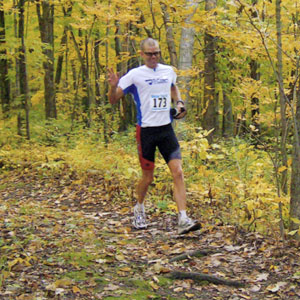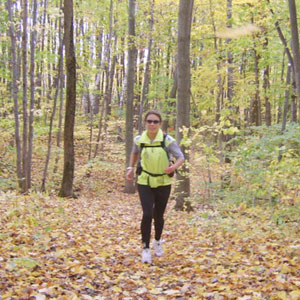The softer side of running

Fall is the season for trail running and racing. After a long and exciting summer of Triathlon training and racing it is easy to feel "burned out." Often this feeling is more mental than physical. Try signing up for a trail running race and see if you can get the spark back.
I speak of this through personal experience many times over. In fact, this happened to me a just a few weeks back. I had just finished a full summer of racing. I competed in 8 triathlons and 3 duathlons; I was even fortunate enough to race in Italy as part of the USA age group National Team. After the last triathlon of the year I felt tired and ready for a break, but a friend of ours talked us into doing the national championship event for adventure racing, which was only a month away. Well, once I put pen to paper I forgot all about needing a break and was eager to get in a couple of long runs before the race. That’s when my wife, Brenda talked me into signing up for a longer trail race.
Even though our interests have varied from year to year, trail running has been one of our main passions; and has been so for over 20 years. I remember the day I got hooked… A friend of mine who was studying exercise physiology at The University of North Carolina at Greensboro asked me to go on a trail run with him. The day was in the late fall of 1986. I was not really all that sure about the idea of a trail run, because after all, I was a “track runner” who could not afford to twist his ankle. Besides I had seen a couple of local trail runners leave the city park and one of them was wearing blue jeans.
Well, I let him talk me into the run and yes I twisted my ankle. But the sense of adventure was just too much for me; I was hooked. Since that day I have done over half of my running on some surface other then asphalt and concrete. My friend’s reason for trail running was actually not the adventure, but the fact that trails or dirt paths are more cushioning than the road.
Back to the longer trail race my wife and I were trying to sign up for. The logic was that since most of our training had been geared towards short, high-speed races, we needed to get “reacquainted” with long trail runs. It just so happened that there was a 50k trail run in a few days… what a fortunate coincidence! The race was the Glacier 50 in Greenbush, Wisconsin, an event that offers both 50k and 50-mile options. The layout of these courses is out-and-back, and we reasoned that in order to avoid getting injured, we would run the “out” part and hike the “back”. We even shook hands on the deal and swore that no matter how good we were feeling, there was no way we would be foolish enough to run an entire 50k when our longest run over the past 3 years was about 12 miles.
The weather was typical fall weather and the leaves were beautiful. About 150 hearty souls showed up, all eager to hit the trail. The 50-miler went off at 6am, while the 50k headed out at 7am. For the 50k, there were aid stations at the 7 and 13-mile marks, with the turn-around at the 15.5-mile marker. You would then hit the same aid stations on the way back. They had a gear drop at the 13-mile aid station, so we sent our adventure racing packs and trekking poles out on the course. Since we would “only be running about 15 miles”, we didn’t carry any food or water with us; our packs had water bladders, so we would be able to drink as much as we wanted on the hike back.

Well, the gun went off promptly at 7am, and we trotted off with the pack. Again, since we were only going to run half of it, Brenda took off at a fairly aggressive pace for her. The pack spread out fairly quickly, and we found ourselves alone after 4 or 5 miles. We were feeling great at the first aid station, and just grabbed a cup of water but not any food. About half way to the next aid station, another couple caught up with us and the four of us ran together for 5 or 6 miles. They were from Marquette, MI, where Brenda was born, so we connected with them right away and enjoyed the company.
Shortly after the 13-mile aid station, the leaders of the 50k started to come back at us. Boy, were they going good! It inspired us and we thought we might go ahead and bend our rule a bit by running back to the aid station, which would total about 17.5 miles of running. We decided that this still wouldn’t be too much running, and would cut down on the “boring” hiking part. Brenda admitted that she was starting to feel the mileage, and didn’t think it would be smart to run more than that.
What is it they say about the best-laid plans? The course marshal at the turn-around greeted us and directed us to the cone to run around. He said we looked great and then cheerfully called out to Brenda as we were running off that she was the third overall woman. We had been somewhat confused by two women ahead of us who were part of team relays. Since Brenda had believed there were quite a few women ahead of her, she hadn’t even thought about overall placing. Well, that little announcement by the course marshal was all it took!
The course was very technical, with many short, steep ups and downs. These all seemed fun and interesting on the way out, but by about mile 25 they weren’t that much fun at all. We were both hurting, but were also too stubborn to just throw in the towel. Since we had abandoned our plan of picking up our hydration packs because we kept running, we were completely dependent upon the aid stations for food and water. Brenda kept saying that the last aid station was “just around the next corner” for about 3 miles. We trudged along and tried to keep our spirits up. Neither of us mentioned the fact that we were blatantly violating our pre-race agreement and committing what we ourselves had termed “foolish” behavior just an hour or so prior.
After what seemed like an eternity, we popped out in the little town of Plymouth, which meant that we were just under a mile from the finish. Since the turn-around, we had only been caught by 3 men but no women. All Brenda had to do was limp home and she would preserve her podium finish! About a quarter mile from the end, we looked back and saw someone coming…uh-oh. Fortunately, it was another man and Brenda gave me the go-ahead to run ahead to keep from getting caught.
Once we were back at the volunteer fire station that served as race headquarters, the pain and suffering was quickly forgotten. It’s amazing what cold water, fresh clothes and chocolate chip cookies fresh out of the oven can do! We congratulated ourselves on a hard-fought effort and immediately started to plot out when we would do our next one.
Here are a few trail running recommendations to get you going and keep you injury free:
• Build your weekly mileage slowly. A good general rule is to not increase your mileage/time more then 5-10% each week.
• Gage your runs off of time not distance. Otherwise you might be drawn to easy and flat trail runs so that you can meet your mileage expectations.
• In general a trail shoe should be a little lower in the heel for added stability. Buy new running shoes every few months and rotate daily between two different shoes.
• On the trails keep your eyes focused on where you want to go and not at the obstacles you want to avoid.
• Later in the run you have to be even more careful. As you get more tired it is easier to twist an ankle.
• Find a few minutes to stretch after each run.
• Consider taking a Yoga class. Most clubs have a class for beginners that will teach you the basics.
• Run on soft surfaces as often as possible. You can even run on the grass next to the road or walking path. The uneven surface will help to strengthen your ankles and even add a bit of a core workout.
• Walk the first .5 or 1 mile of your running route. The older you are the more this makes sense.
• Don’t run if you are sore from running. Remember as triathletes we have options. Rather than hobble through a run when sore bike, swim, walk, etc…
• Vary the distance and speed of your runs. Never do the same run at the same speed more than once a week.
• Lose 5 pounds. Losing weight is the easiest way to reduce the pounding on your body that running can dish out.
• Build core strength. The uneven surfaces of the trail can add an extra layer of stress to your running, so get a jump start on the trail running season by building your core strength.
• Sign up for a local trail running race. I promise you will have an unforgettable experience. You might even get to run next to a guy in blue jeans.
Okay…it is time to find your local dirt trails. I think you will be amazed by how much better you will feel if you do your long runs on trails.
The author Lee Simril is a triathlon coach previously based in Wisconsin who just moved back to Tennessee. His company is PRTriCoach.com


